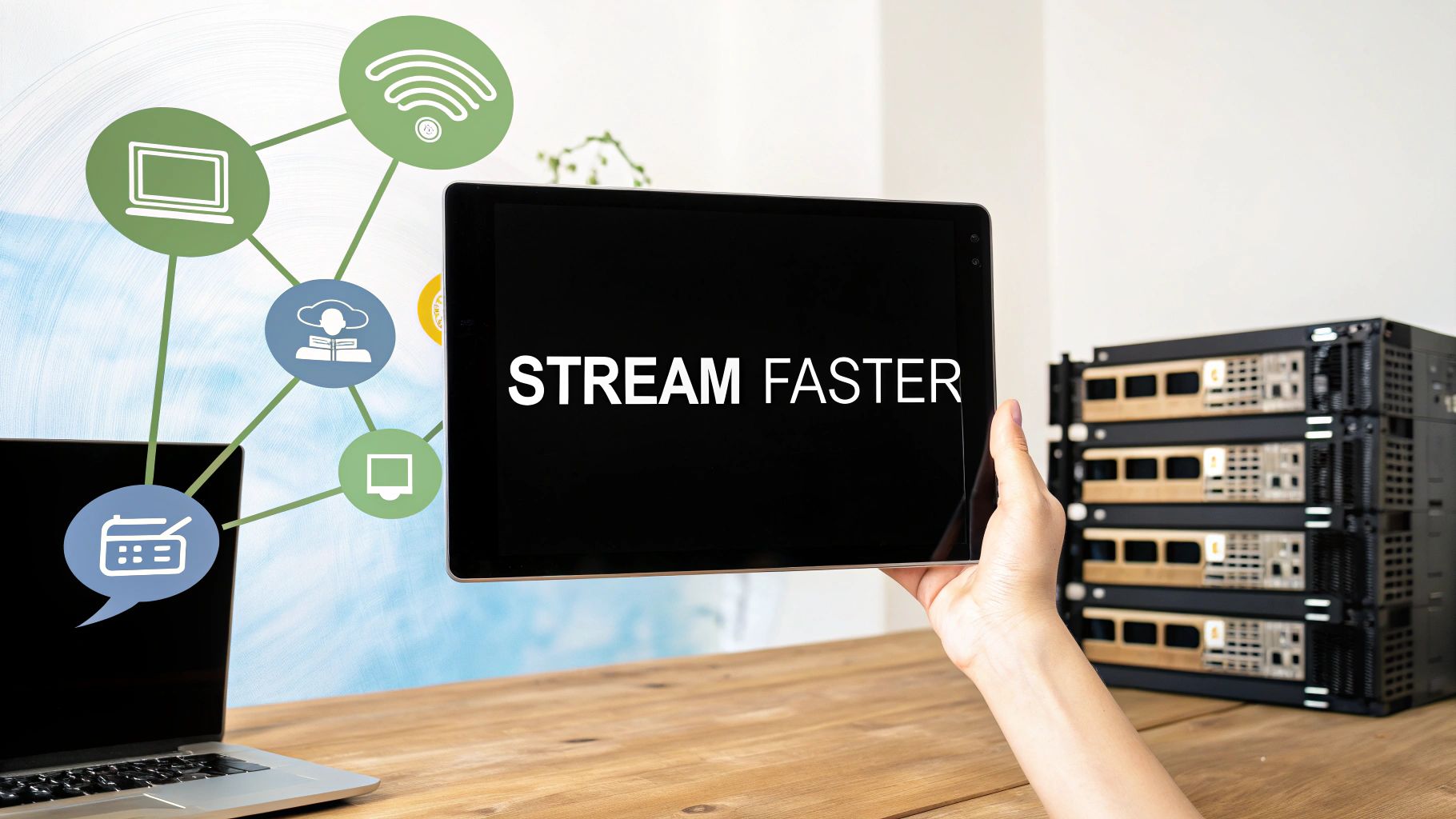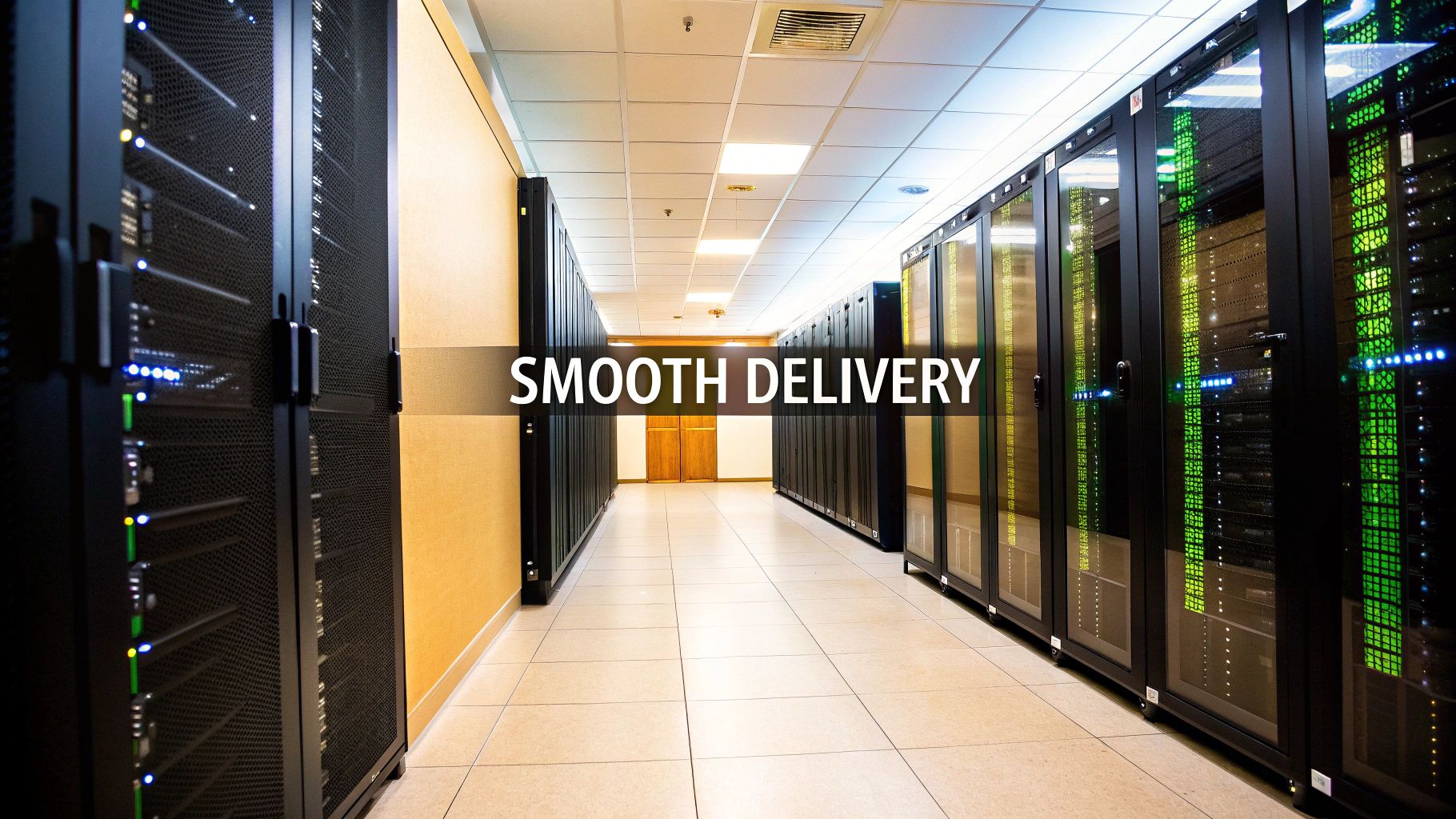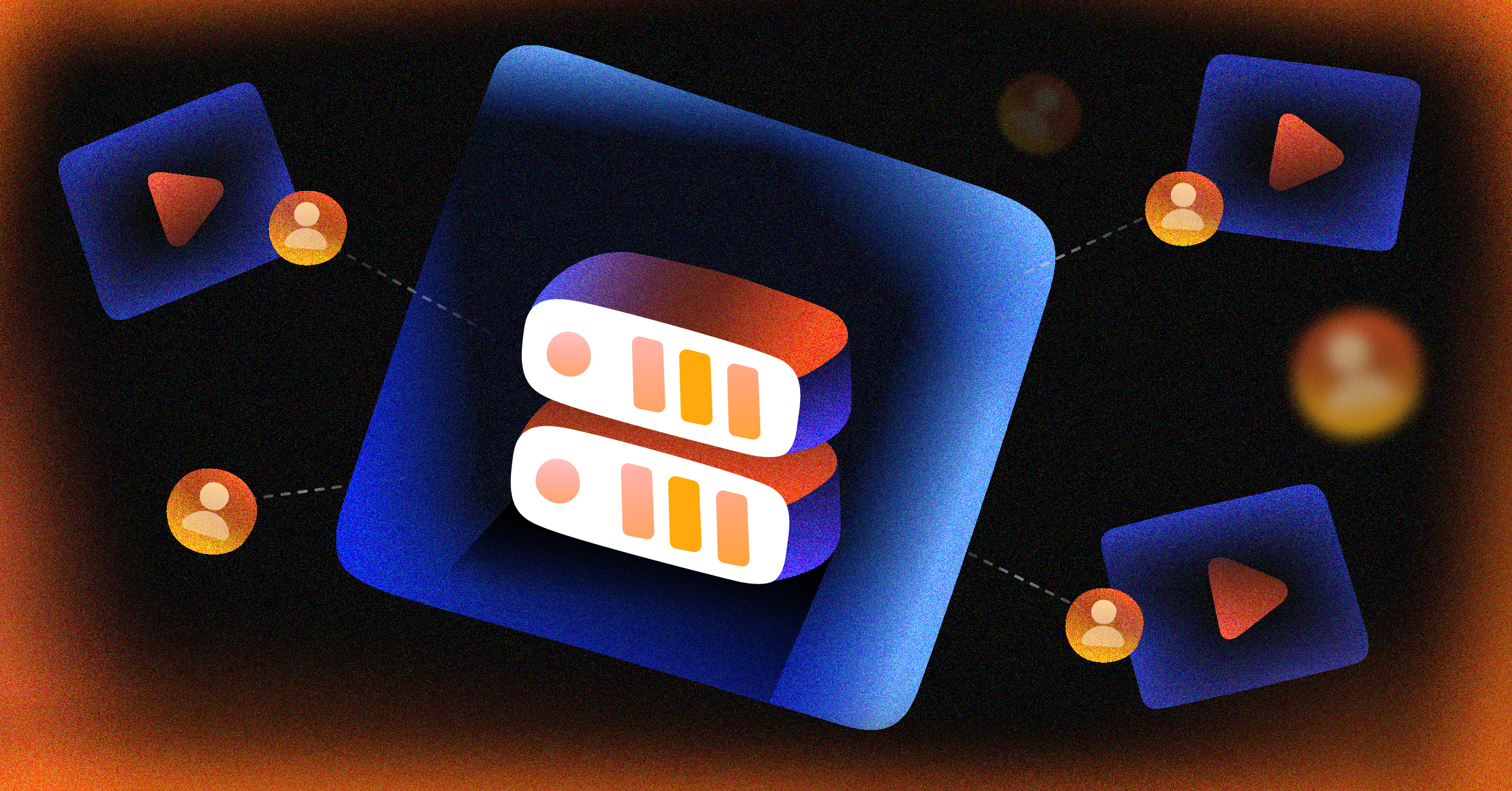Ever wondered how a global sports final can stream flawlessly to millions of people at once, while a small company webinar buffers endlessly? The secret sauce is almost always a Content Delivery Network, or CDN.
A CDN is a globe-spanning network of servers designed to deliver your live video from a location physically close to your viewers. This simple idea—closing the distance—is what drastically cuts down on lag and boosts the quality of your stream.
Why Flawless Live Streaming Depends on a CDN
Think of your main server (the “origin”) as a single, wildly popular food truck trying to serve an entire city. As the crowd swells, the line gets longer, service grinds to a halt, and a lot of hungry people walk away disappointed.
A CDN for live streaming is like franchising that food truck and putting a fully stocked kitchen in every neighborhood. When a viewer wants to watch your stream, they get the video feed from the local “kitchen” just a few blocks away, not from the original truck all the way across town.
This distributed model tackles the two biggest enemies of live video: distance (latency) and traffic volume (scalability). Without it, every single viewer would have to connect directly to your main server, no matter where they are. That’s a recipe for a digital traffic jam, leading straight to the dreaded buffering wheel, frozen screens, and a terrible user experience.
The Foundation of a Booming Industry
The need for this kind of infrastructure is exploding right now. Live streaming has gone from a niche hobby to a massive global industry. As of 2024, the global live streaming market was valued at around USD 100 billion—that’s a nearly fourfold jump from just five years ago.
Experts predict the market could swell to USD 345 billion by 2030, fueled by enormous audiences and new monetization models like advertising and virtual gifting. If you want to dig deeper, you can explore more of these live streaming statistics to see just how fast this space is growing.
This incredible growth puts immense pressure on the tech holding it all together. A CDN isn’t a “nice-to-have” anymore; it’s a fundamental requirement for anyone serious about broadcasting. It’s what ensures your stream can handle a sudden flood of viewers and deliver a consistent, high-quality experience every time.
A CDN isn’t just about speed; it’s about reliability and scale. It’s the difference between broadcasting to a small room and filling a global stadium, ensuring every single person gets a perfect view of the event.
How a Live Streaming CDN Delivers Your Video
Let’s pull back the curtain and trace your live video’s journey, from the lens of your camera to your audience’s screens. It’s a lightning-fast relay race that happens in the blink of an eye, all designed to make sure your viewers don’t miss a single moment. The whole system is built on a simple, step-by-step process focused on speed and rock-solid reliability.
It all starts the moment your live feed hits a central origin server. You can think of this as the main broadcast hub for your stream. This is where your original, high-quality video feed first lands, getting prepped for its trip around the world.
But before it heads out, the stream goes through a crucial step called transcoding. The origin server essentially creates multiple versions of your video at different quality levels and bitrates. It’s like making small, medium, and large copies of the same video, ensuring there’s a perfect fit for every viewer—whether they’re on a blazing-fast fiber connection or a spotty 4G signal.
The Global Relay Race
With all the different versions ready, the CDN for live streaming kicks into gear, pushing them out across its entire network. This network is a massive web of strategically located servers known as Points of Presence (PoPs). Each PoP acts like a local broadcast station, holding a cached copy of your stream.
So, when a viewer in London hits the play button, their request doesn’t have to travel thousands of miles back to your origin server in Los Angeles. Instead, it gets routed to the closest PoP, maybe just a few city blocks away. This simple trick of closing the physical distance is what slashes latency and gets rid of that annoying, stream-killing lag.
This infographic breaks down how a CDN completely changes the game, solving the classic problems of streaming from a single, far-away server.
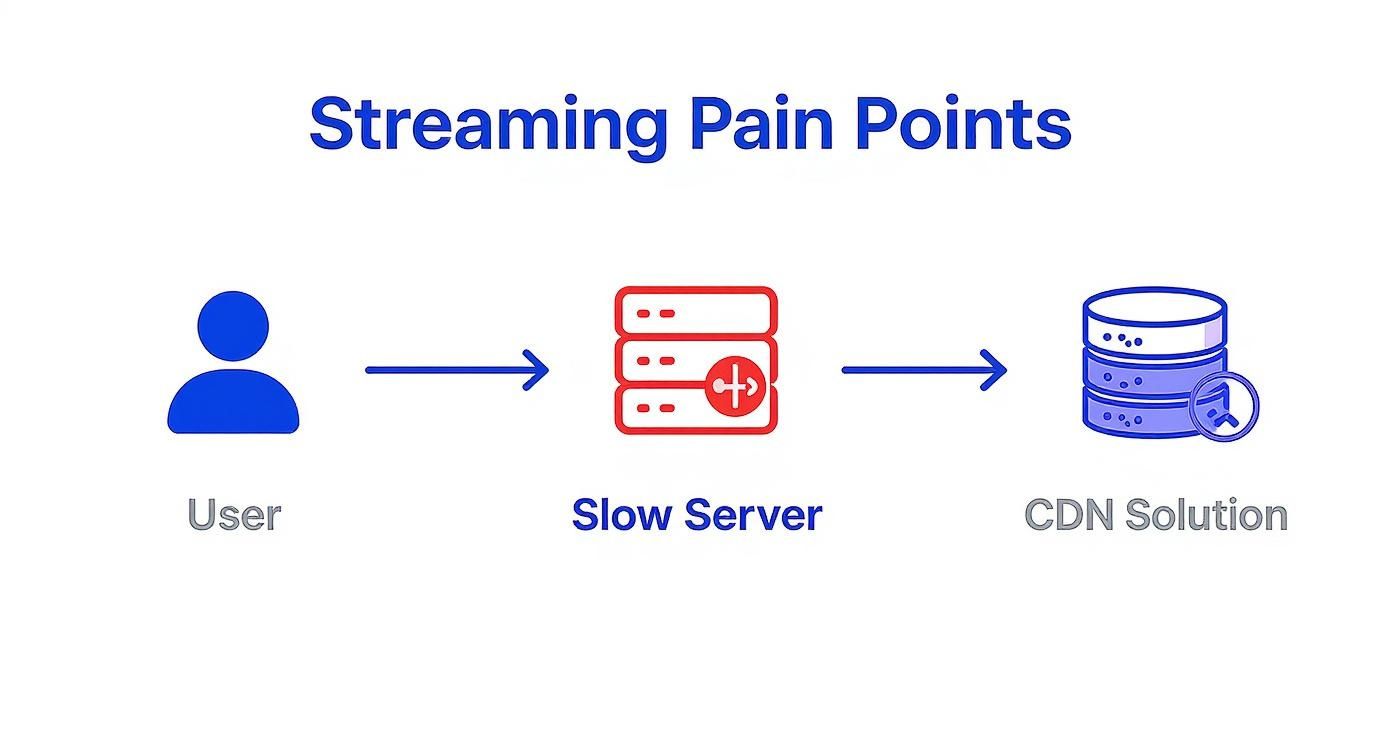
As you can see, the CDN acts as a powerful middleman, bringing the content right to the user’s doorstep for a flawless viewing experience.
Adapting to Every Viewer’s Connection
But bringing the stream closer is only half the battle. Modern CDNs also power something called adaptive bitrate streaming (ABR), a clever technology that keeps the video playing no matter what. ABR works directly with those different transcoded versions we talked about earlier.
Here’s a quick look at how it works in the real world:
- Initial Connection: The viewer’s video player first requests a medium-quality piece of the stream to get things started quickly.
- Network Monitoring: In the background, it’s constantly keeping an eye on the viewer’s internet speed and stability.
- Smart Switching: If the connection is solid, the player automatically upgrades to a higher-quality HD or 4K version. If the connection suddenly drops—maybe the viewer walks into a room with bad Wi-Fi—it instantly switches down to a lower-quality version to keep the stream alive.
This all happens seamlessly, without the viewer even noticing a change. The main goal of ABR is to keep the video playing continuously, prioritizing smooth playback over perfect quality and stopping that dreaded buffering wheel in its tracks.
This entire system is built on modern streaming protocols. To really dig into the technical side, you can learn more about how HTTP Live Streaming (HLS) breaks video into small chunks, which is what makes this whole process tick. By pairing a global network of PoPs with the intelligence of adaptive streaming, a CDN makes sure every single viewer gets the best possible experience their device and connection can handle.
What a CDN Actually Does for Your Live Stream
It’s one thing to understand the technical side of a Content Delivery Network, but what really matters is how it directly impacts your viewers and the success of your broadcast. The benefits aren’t just theoretical; they translate into real, measurable advantages that protect your stream, keep your audience hooked, and let you scale without hitting a wall.
Think of a CDN as an insurance policy against the most common headaches in live broadcasting. It’s the behind-the-scenes hero that makes your ambitious streaming goals possible.
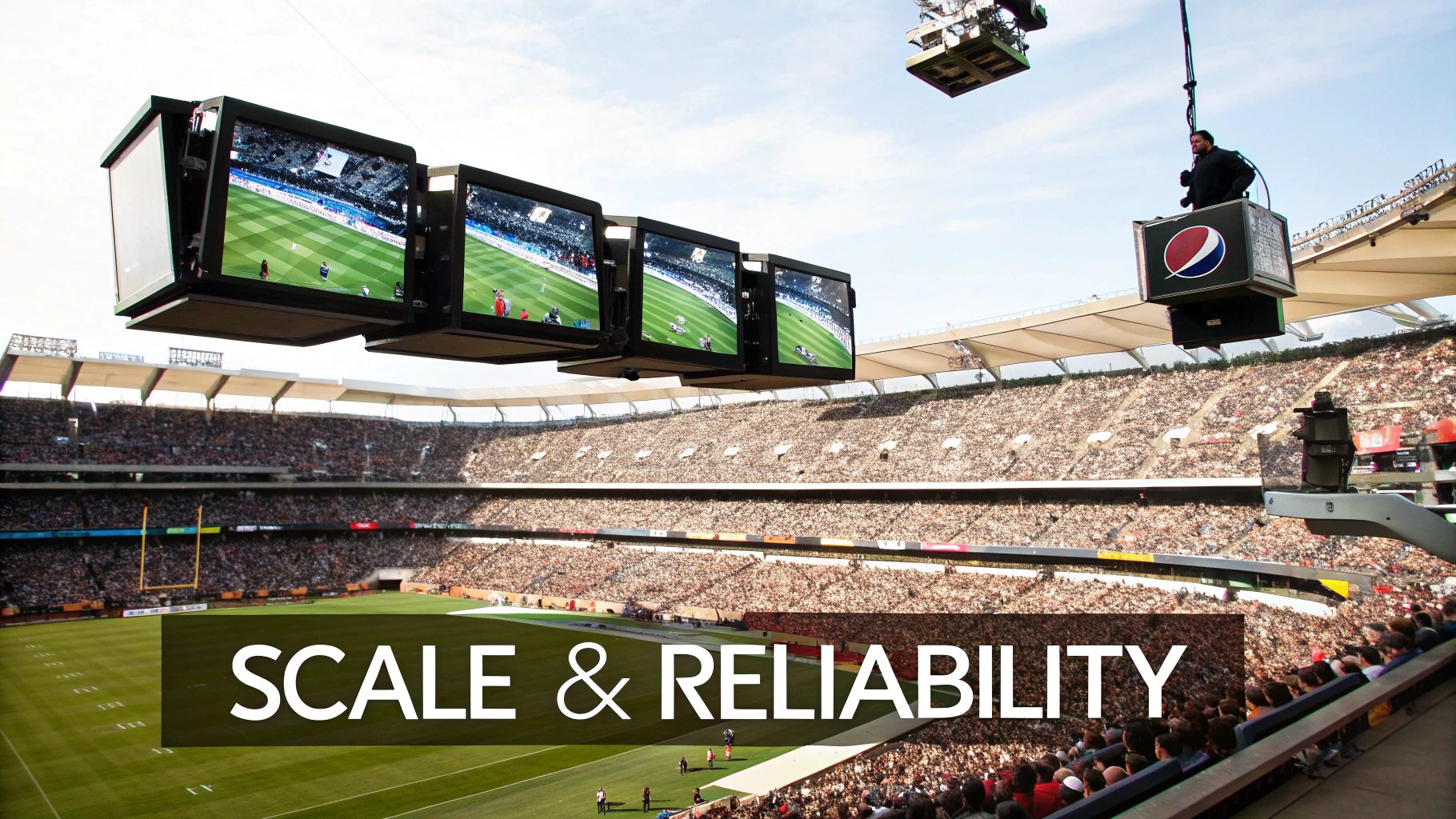
Slash Latency for a True Real-Time Feel
The first thing you’ll notice is a huge drop in latency. Without a CDN, if someone in Tokyo tries to watch a stream originating from New York, the data has to travel halfway across the world. That massive delay can completely derail interactive events like live Q&As or auctions.
A CDN solves this by serving the stream from a local server right there in Tokyo. The frustrating lag disappears, replaced by a near-instantaneous experience that keeps everyone in sync. For a deeper look at this and other common issues, check out our guide on what causes buffering when streaming.
Go from a Handful of Viewers to Millions, Instantly
Picture this: your stream unexpectedly goes viral. Your audience count explodes from a hundred to one hundred thousand in just a few minutes. A single origin server would simply crumble under that kind of pressure, leading to a complete crash.
This is exactly the kind of scenario a CDN is built for. It intelligently spreads the traffic load across its massive network, so no one server ever gets overwhelmed. This gives you the freedom to handle huge, unpredictable audiences without worrying about a single point of failure.
A CDN doesn’t just make your stream faster; it makes it resilient. It’s the architectural difference between a system that can serve a small town and one that can serve the entire world simultaneously.
Deliver Unbreakable Reliability and Security
In the world of live streaming, reliability is everything. If one CDN server happens to go offline, the network automatically reroutes viewer traffic to the next-closest healthy server. This built-in redundancy means your stream stays online, no matter what, providing a seamless experience for your audience.
On top of that, a good CDN for live streaming adds a crucial layer of security. It can shield your broadcast from disruptive events like DDoS attacks by absorbing the malicious traffic at the edge of its network. This keeps your origin server safe and your stream running without a hitch. This kind of stability is a major reason why the video streaming market, valued at an incredible USD 129.26 billion in 2024, keeps expanding. You can find more details in the latest video streaming market growth report from Grand View Research.
To pull these ideas together, here’s a quick summary of how a CDN’s technical features translate into tangible benefits for both you and your audience.
CDN Benefits for Live Streaming at a Glance
| Benefit | Technical Mechanism | Impact for Viewers | Impact for Broadcasters |
|---|---|---|---|
| Reduced Latency | Caching content on edge servers close to users. | Near real-time experience, better for interactive events. | Higher audience engagement and satisfaction. |
| Massive Scalability | Distributing traffic load across a global network. | Smooth, buffer-free viewing even during traffic spikes. | Ability to handle viral moments without crashes. |
| High Reliability | Automatic failover and server redundancy. | Uninterrupted stream, even if a server fails. | Peace of mind and protection against downtime. |
| Enhanced Security | DDoS mitigation and traffic filtering at the network edge. | A stable, secure viewing experience. | Origin server is protected from malicious attacks. |
Ultimately, integrating a CDN isn’t just a technical upgrade; it’s a strategic move to ensure your live broadcasts are professional, scalable, and resilient enough to handle anything.
Choosing the Right CDN for Your Live Stream
Not all CDNs are created equal, especially when your goal is flawless, real-time video delivery. When you start shopping around, you have to look past the big marketing claims and get down to the technical details that actually matter for performance. A generic CDN built for websites just won’t cut it; you need a network specifically tuned for the unique, punishing demands of live video.
The trick is to match a CDN’s real-world capabilities to your audience and content. This decision directly impacts everything from viewer experience and security to your ability to handle a sudden surge in traffic. Asking the right questions upfront will save you from some serious headaches down the road.
Evaluate Geographic Coverage and PoP Strategy
It’s easy to get fixated on the total number of Points of Presence (PoPs) a CDN boasts. But while a huge number might look impressive on a sales page, their strategic location is what truly counts.
Think about it: if your audience is concentrated in Southeast Asia, a CDN with thousands of PoPs in North America isn’t going to deliver that snappy, low-latency experience you’re after. The goal is to shrink the physical distance your stream has to travel. That’s the most effective way to crush lag and buffering.
The most crucial question to ask a potential CDN provider is not “How many PoPs do you have?” but “Where are your PoPs located in relation to my target audience?” Proximity is the ultimate performance metric for a CDN for live streaming.
Ensure Support for Modern Streaming Protocols
The protocols a CDN supports dictate how your video is packaged and shipped across the internet. Different protocols are built for different jobs, so it’s vital to pick a CDN that speaks the right language for your stream.
Here are the essentials to look for:
- HLS (HTTP Live Streaming): This is the workhorse of the industry. It’s the standard for one-to-many broadcasting and offers fantastic compatibility across most devices and browsers.
- DASH (Dynamic Adaptive Streaming over HTTP): As an open-source alternative to HLS, DASH is also a rock-solid choice for adaptive bitrate streaming and has widespread support.
- WebRTC (Web Real-Time Communication): If you need lightning-fast, interactive streaming for things like live auctions or two-way video calls, WebRTC support is absolutely non-negotiable.
Your choice of protocol directly impacts latency and the overall viewer experience, so make sure your CDN is aligned with your technical game plan. For a deeper dive, our guide on the best CDNs for video streaming breaks these differences down even further.
Prioritize Security and Analytics
Delivering a smooth stream is only half the battle. You also have to protect your content and understand your audience. A robust CDN should offer critical security features to safeguard your revenue and intellectual property.
Look for tools like DRM (Digital Rights Management) to prevent piracy and token authentication to control exactly who can access your stream.
On top of that, don’t overlook analytics. Basic metrics like viewer counts are table stakes. You need real-time data on stream quality, buffering rates, and where your viewers are tuning in from. These insights let you spot and solve problems before they escalate, ensuring you deliver the best possible quality of experience to every single person watching.
Diving into Different Live Streaming Architectures
Picking a CDN for live streaming isn’t just about choosing a brand. You have to understand the technical blueprint—the architecture—that will actually power your broadcast. After all, the needs for a global sports final are wildly different from an interactive Q&A session, and the right architecture is what makes or breaks the experience. Let’s dig into the three main models you’ll encounter.

These aren’t one-size-fits-all solutions. The best choice comes down to a simple question: are you trying to reach millions with a stable broadcast, or are you aiming to create an intimate, real-time conversation?
The Classic One-to-Many Broadcast
This is the workhorse of the live streaming world. Think of a concert, a corporate town hall, or a major news event. You have one source streaming out, and the CDN’s job is to efficiently push that content to thousands, or even millions, of viewers.
This setup is built for two things: stability and massive scale. The whole point is to deliver a high-quality, reliable stream to a large, mostly passive audience. You’ll have a bit more latency—a few seconds of delay is pretty standard—but that’s a small price to pay for ensuring the broadcast is rock-solid for everyone watching. Here, reach and consistency are king.
P2P-Assisted CDN for Massive Scale
What happens when you’re broadcasting a truly gigantic event, like a World Cup final? Even the most powerful CDN can start to feel the pressure. That’s where a clever hybrid model comes into play: a peer-to-peer (P2P) assisted architecture. This system essentially turns your audience into a network of tiny broadcast helpers.
It’s a pretty elegant solution:
- The CDN still delivers the initial stream to each viewer.
- But once they’re watching, their device starts sharing tiny, non-critical pieces of the stream with other nearby viewers.
- This creates a powerful mesh network that takes a huge load off the central CDN servers.
This approach dramatically slashes server costs and makes the entire network more resilient, especially during those insane viewership spikes that would otherwise cripple a traditional setup. The demand for this kind of innovation is exploding; the global CDN market is on track to hit USD 60 billion by 2035, a massive leap driven by our insatiable appetite for video. You can find more details about this explosive CDN market growth in recent industry reports.
WebRTC for Ultra-Low Latency
But what if your stream needs real-time interaction? Think online auctions, remote medical consultations, or live gaming. A delay of even a few seconds would make the whole thing fall apart. For these use cases, WebRTC (Web Real-Time Communication) is the go-to architecture.
WebRTC is the gold standard for interactive, two-way streaming. It bypasses traditional protocols to create a direct, near-instantaneous connection between participants, achieving sub-second latency.
This architecture isn’t designed for broadcasting to millions. Instead, it’s all about creating conversational, real-time experiences where every single millisecond matters. It’s the magic behind video conferencing platforms and any application where immediate feedback is absolutely critical to success.
Got Questions About Live Streaming CDNs?
You’ve got the theory down, but as you get ready to go live, the real-world questions start popping up. It’s one thing to understand what a CDN does, but it’s another to figure out the nitty-gritty details for your specific stream.
Let’s clear the air. Think of this as a quick-fire Q&A to tackle the most common things people wonder about when putting a live streaming CDN into practice. We’ll cover everything from CDN types to latency and who’s responsible for what.
Aren’t All CDNs Basically the Same? (Live vs. Website CDNs)
It’s a fair question. On the surface, all CDNs seem to have the same job: get content to users faster. But under the hood, a CDN built for live video and one made for a regular website are engineered for completely different worlds.
A website CDN is a master of caching. It’s designed to grab static files—images, CSS, JavaScript—and hold onto them for a long time, serving the same copy to thousands of users. A live streaming CDN, on the other hand, is built for constant motion. It handles a relentless flow of tiny video chunks that are only relevant for a few seconds before being replaced. The whole system is optimized for low latency and lightning-fast data turnover, not long-term storage.
A website CDN is like a warehouse, stocking up on goods (files) that don’t change often. A live streaming CDN is more like a fresh fish market, where everything (video segments) arrives, gets delivered, and is replaced in a matter of moments.
What’s a “Good” Latency for a Live Stream?
“How low should we go?” is one of the first questions everyone asks. The truth is, the “right” latency depends entirely on what you’re streaming. There’s no single magic number, but we can break it down into a few clear tiers.
- Broadcast-Style Streams (20-30 seconds): Think concerts, church services, or company-wide announcements. Here, a little delay is no big deal. A latency of 20-30 seconds is perfectly fine and often gives you better stability and higher video quality.
- Interactive Events (5-15 seconds): When you need the audience to participate with things like live polls or a Q&A chat, you need to tighten things up. Aiming for the 5 to 15-second range keeps the back-and-forth feeling natural and connected.
- Real-Time Communication (<1 second): For anything that needs to feel like a genuine conversation—like a video conference, online auction, or two-way interview—you need to be under one second. This is ultra-low latency territory, which almost always means using a WebRTC-based setup.
Can I Use More Than One CDN at a Time?
Absolutely! And for any high-stakes, can’t-fail event, you probably should. Running a multi-CDN strategy is the ultimate safety net.
It gives you a powerful layer of redundancy. If your primary CDN has a regional hiccup or a performance snag, your video player can be smart enough to automatically flip over to a backup provider. This ensures your stream stays up and running, protecting you from a single point of failure. It’s the best insurance policy you can get for a major broadcast.
Who’s in Charge of Video Transcoding?
So, who handles the heavy lifting of transcoding—the process of turning your single high-quality video feed into the multiple different bitrates needed for adaptive streaming? This task can live in one of two places.
- You Do It Yourself: You can run your own encoding software or hardware to create all the different quality streams before you send them to the CDN. This gives you complete, granular control over every encoding setting.
- The CDN Does It: Many modern CDNs offer cloud transcoding as a service. You just send them your one pristine, high-quality stream, and their platform takes care of all the transcoding and packaging for you. This dramatically simplifies your workflow.
The best option really comes down to your team’s technical know-how, your budget, and how much control you want over the final video output.
Ready to build a powerful, scalable live streaming experience without the infrastructure headaches? LiveAPI integrates with the world’s leading CDNs to give you flawless video delivery out of the box. Explore our robust APIs and start building today.








